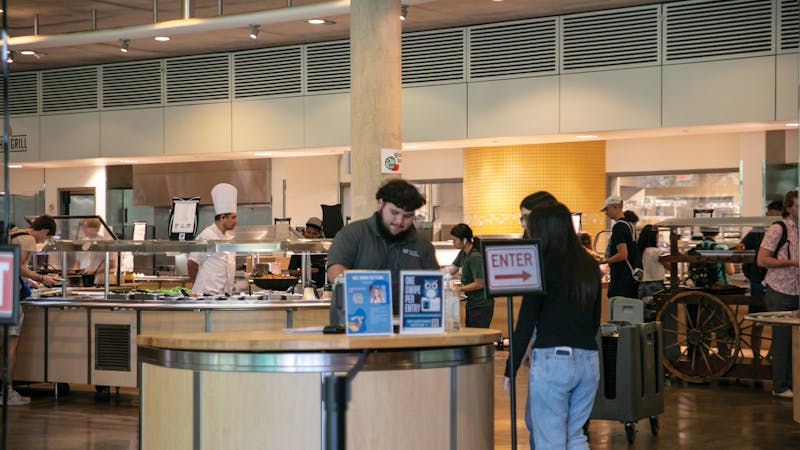Rice researchers develop two new sensors to detect COVID-19

Researchers at Rice University have been developing two new innovative tools to detect COVID-19: a real-time sensor that can detect small amounts of the virus in the air and a mobile phone reader with a chip that can detect the virus from a blood sample.
The RAPID Project
The Real-Time Amperometric Platform Using Molecular Imprinting for Selective Detection of SARS-CoV-2 Project involves developing a thin film electronic device that senses as few as eight SARS-CoV-2 viruses in 10 minutes of sampling air flowing at eight liters per minute, per a press release.
Naomi Senehi, a second-year graduate student in the Pedro Alvarez lab at Rice, said that the idea originated from studying how molecular imprinting can be used to capture pollutants in wastewater. Molecular imprinting is a technique to create template-shaped cavities that have high specificity and affinity for a certain molecule and is based on the “lock and key” model used by enzymes for recognizing certain molecules during reactions.
“We saw that we could also use imprinting to capture a live virus,” Senehi said. “This would be a cool idea for a sensor rather than a quick diagnostic tool.”
Senehi explained that the sensor is made with glass coated in polymers that have an imprint of the live virus. When the virus comes into contact with the sensor and fits snugly into one of the imprinting cavities, an electric signal is released. The molecular imprinting makes the sensor highly selective for the virus, but there is also flexibility in application for future imprints.
“My main contribution is method development of how to imprint fragile live viruses into a complex polymer,” Senehi said. “This has been an interesting experience, and it is my first lab project at Rice. It’s been fun, very exhilarating and very challenging.”
According to Rafael Verduzco, a professor of chemical and biomolecular engineering and of materials science and nanoengineering and a principal investigator on the project, the sensor has three basic components. One is for sampling the air to detect the virus, a second for binding to the virus and a third for communicating binding events as electronic signals (transduction).
“Our focus is on selective binding and electronic transduction,” Verduzco said. “We achieve selective binding through molecular recognition layers known as molecularly imprinted polymers. We transduce electronic signals using organic electrochemical transistors [that] amplify binding events and enable us to immediately detect that the virus has been adsorbed by the device.”
Yizhi Jane Tao, a structural virologist and professor of biochemistry at Rice, is another major contributor to the project. According to Tao, her lab is responsible for identifying attachment factors that can selectively bind COVID-19 in an air sample. This involves producing attachment factors in the lab and then testing specificity and binding affinity before attaching them to the sensor.
“We are very optimistic since there are several papers that indicate there are many molecules that can selectively bind the virus and also be ordered commercially,” Tao said.
Like Senehi, Tao said she agrees that the sensor is flexible for future pathogens since the ideas and principles can be transferred; one just needs to switch the attachment factors and change its activity to other molecular components in air.
The project has received up to $1 million in funding from the Defense Advanced Research Projects Agency and the National Science Foundation.
“The project moves at a very fast pace,” Tao said. “DARPA has milestones since they give funding by stage, so if we want to continue moving beyond six months, we need to achieve satisfactory results.”
Tao, Senehi and Verduzco said they agree that the biggest advantages of using the sensor are that it would not require a lab and is more real-time. According to Verduzco, the sensor would also be the first device capable of detection of the virus in air. The sensor is currently still under development, but Tao said that the prototype will first be tested at Rice.
“Right now, the sensor is very expensive because we have been focusing on the technical side, so it is more practical for use in public indoor spaces to serve as a warning if the surrounding air contains COVID-19 particles,” Tao said.
Phone Sensor Detection Tool
Rice engineers have also developed a plug-in tool that can diagnose minute amounts of SARS-CoV-2, the virus that causes COVID-19, in around 55 minutes.
According to Peter Lillehoj, principal investigator on the project and Shankle chair in mechanical engineering at Rice, the device contains a microfluidic chip that measures the concentration of SARS-CoV-2 nucleocapsid protein, a biomarker for an active COVID-19 infection, in a fingerprint blood sample.
Magnetic nanobeads then bind to the SARS-CoV-2 protein in the chip and transport it to an electrochemical sensor that detects minute amounts of the protein. The chip can then be plugged into a mobile phone reader app for measurements, and results are displayed on the phone.
“We have already developed a working prototype in the lab and tested on a handful of samples with and without COVID-19,” Lillehoj said. “The test was pretty accurate, but we want to test on more samples. This takes additional time and resources, so we are trying to figure out the best way to go about getting funding and getting volunteers to test.”
Lillehoj also said there are many benefits of using this device over other COVID-19 detection tools.
“The sensor is a very portable device, and one would just need a handheld mobile phone reader and a disposable microfluidic chip. You could run tests at a collection site or some clinic without transporting to a central lab for analysis,” Lillehoj said. “It could take less than an hour to get results, and based on testing, this method is just as reliable as the [polymerase chain reaction] test.”
More from The Rice Thresher

Dis-O, move-in weekend see increase in alcohol transports from last year
Rice’s first wet weekend of the year saw four times as many calls for intoxication-related transports of students to the hospital compared to the previous three years, according to emails sent out by college presidents and chief justices.

On-campus meal plan changed to unlimited swipes
Housing and Dining recently revealed a new dining plan for the upcoming semester. The required on-campus meal plan now has unlimited meal swipes, compared to 375 meal swipes last year. H&D said the previous on-campus meal plan was for students who intended to eat on campus 15 to 25 meals a week.

Rice Stadium student section relocated
The Rice Stadium student section has been relocated to sections 106 and 107, according to an announcement from Rice Athletics on X.

Please note All comments are eligible for publication by The Rice Thresher.